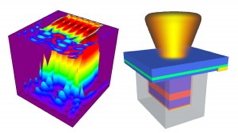Science
NASA Pinpoints Causes of 2011 Arctic Ozone Hole

Maps of ozone concentrations over the Arctic come from the Ozone Monitoring Instrument (OMI) on NASA’s Aura satellite. The left image shows March 19, 2010, and the right shows the same date in 2011. March 2010 had relatively high ozone, while March 2011 has low levels.
- Read more
- 358 reads
Herschel gets to the bottom of black-hole jets

Artist's impression of the GX 339-4 black-hole binary system.
- Read more
- 478 reads
Breaking the final barrier: room-temperature electrically powered nanolasers

The illustration on the left shows the variations of light intensity within a nanolaser. The figure on the right shows schematically a nanolaser with a metallic cavity, where the center red region confines electrons and the grey enclosure is a silver cavity. The blue layer on top is a substrate where the laser structure is grown. The orange-yellow color on top indicates the light emission. Research led by Arizona state University engineering professor Cun-Zheng Ning has produced nanolasers that can operate under a battery power at room temperatures – instead of only in refrigerated conditions – which opens the door to use of the lasers in many practical applications in modern electronics.
- Read more
- 516 reads
High-performance, NW-OPTs open the way for optoelectronic device miniaturization

Schematic diagram of single-crystalline nanowire organic phototransistors
- Read more
- 349 reads
Temp-controlled 'nanopores' may allow detailed blood analysis

By tethering gold nanoparticles (large spheres in top image) to the nanopore (violet), the temperature around the nanopore can be changed quickly and precisely with laser light, allowing scientists to distinguish between similar molecules in the pore that behave differently under varied temperature conditions.
- Read more
- 380 reads
University of Illinois researchers develop novel technique for chemical identification at the nanometer scale

Atomic force microscope infrared spectroscopy (AFM-IR) of polymer nanostructures.
- Read more
- 439 reads
Russian Scientists Might Have Found New Life Under Antarctic Ice
Russian scientists say they might have found new life forms in a fresh-water Antarctic lake that has been sealed off from the world for 14 million years.
- Read more
- 352 reads
Measuring the Universe More Accurately Than Ever Before — New results pin down the distance to the galaxy next door

- Read more
- 450 reads
Biobatteries catch breath

New air-breathing cathode for miniaturised biofuel cells, developed by a team of researchers from the Institute of Physical Chemistry of the Polish Academy of Sciences in Warsaw. The cathode consumes oxygen from air. Pictured above: Adrianna Złoczewska, a PhD student at the IPC PAS.
- Read more
- 354 reads
Human Rights
Fostering a More Humane World: The 28th Eurasian Economic Summi

Conscience, Hope, and Action: Keys to Global Peace and Sustainability

Ringing FOWPAL’s Peace Bell for the World:Nobel Peace Prize Laureates’ Visions and Actions

Protecting the World’s Cultural Diversity for a Sustainable Future

Puppet Show I International Friendship Day 2020


